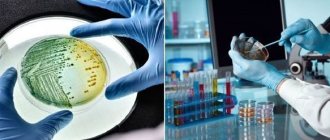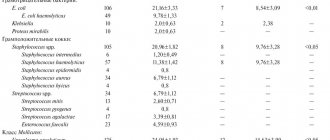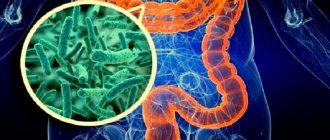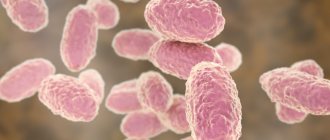Table 1. Qualitative and quantitative composition of the main microflora of the large intestine in healthy people (CFU/g Feces)
(Industry standard 91500.11.0004-2003 “Protocol for the management of patients. Intestinal dysbiosis” - APPROVED by order of the Ministry of Health of Russia dated 06/09/2003 N 231)
| Types of microorganisms | Age, years | ||
| < 1 | 1-60 | > 60 | |
| Bifidobacteria | 1010 — 1011 | 109 — 1010 | 108 – 109 |
| Lactobacilli | 106 — 107 | 107 – 108 | 106 — 107 |
| Bacteroides | 107 – 108 | 109 — 1010 | 1010 — 1011 |
| Enterococci | 105 — 107 | 105 – 108 | 106 – 107 |
| Fusobacteria | < 106 | 108 – 109 | 108 – 109 |
| Eubacteria | 106 — 107 | 109 — 1010 | 109 — 1010 |
| Peptostreptococci | < 105 | 109 — 1010 | 1010 |
| Clostridia | <= 103 | <= 105 | <= 106 |
| Escherichia (E.coli): | |||
| E. coli typical | 107 – 108 | 107 – 108 | 107 – 108 |
| E. coli lactose negative | < 105 | < 105 | < 105 |
| E. coli hemolytic | 0 | 0 | 0 |
| Other opportunistic enterobacteria <*> | < 104 | < 104 | < 104 |
| Staphylococcus aureus | 0 | 0 | 0 |
| Staphylococci (saprophytic, epidermal) | <= 104 | <= 104 | <= 104 |
| Yeast-like fungi of the genus Candida | <= 103 | <= 104 | <= 104 |
| Non-fermenting bacteria <**> | <= 103 | <= 104 | <= 104 |
<*> - representatives of the genera Klebsiella, Enterobacter, Hafnia, Serratia, Proteus, Morganella, Providecia,
Citrobacter etc.
<**> - Pseudomonas, Acinetobacter, etc.
The microorganisms listed in the dysbacteriosis analysis form can be divided into three groups:
- lactic acid bacteria of normal microflora - mainly bifidobacteria and lactobacilli,
- pathogenic enterobacteria,
- opportunistic pathogenic flora (OPF).
Lactic acid bacteria
The basis of the normal intestinal microflora is lactic acid bacteria - bifidobacteria, lactobacilli and propionic acid bacteria with a predominance of bifidobacteria, which play a key role in maintaining the optimal composition of the biocenosis and its functions. A drop in the number of bifidobacteria and lactobacilli below normal indicates the presence of problems in the body. At a minimum, this is inflammation on the mucous membranes and a decrease in immune defense.
Pathogenic enterobacteria
Pathogenic enterobacteria are bacteria that can cause acute intestinal infections (the causative agents of typhoid fever are Salmonella, the causative agents of dysentery are Shigella, the causative agents of yersiniosis are Yersinia, etc.). Their presence in feces is no longer just dysbacteriosis, but an indicator of a dangerous infectious intestinal disease.
Opportunistic pathogenic flora (OPF)
Opportunistic flora includes lactose-negative enterobacteria, clostridia, various cocci, etc. The essence of these microbes is reflected in the name of the group: “opportunistic”. Normally they do not cause any problems. Many of them can even be beneficial to the body to a certain extent. But if the norm is exceeded and/or the immune defense is ineffective, they can cause serious diseases. By competing with beneficial bacteria, opportunistic flora can become part of the intestinal microbial film and cause functional disorders, inflammatory and allergic diseases.
It is possible for opportunistic flora to enter the blood through the intestinal wall and spread throughout the body (translocation), which is especially dangerous for young children and people with severe immunodeficiencies, in whom these microorganisms can cause various diseases, including life-threatening ones.
Detailed description of the study
This study makes it possible to confirm or refute the assumption about the role of staphylococcus in problems with the gastrointestinal tract. Also, with its help, the doctor can determine the sensitivity of the pathogen to antibiotics and bacteriophages, select the most optimal drug, monitor the dynamics of the disease and the effectiveness of treatment.
Why is Staphylococcus aureus dangerous?
Staphylococcus aureus is a gram-positive opportunistic bacteria that can be present on the skin and mucous membranes normally, including around the anus (in 30% of cases it is detected in healthy people), without causing pathological changes. However, this microorganism sometimes causes the development of an inflammatory process.
The pathogen can be transmitted through household contact. The source is usually an infected person, a carrier of the infection (no symptoms). If the immune system is not strong enough, the balance of microflora is disturbed, or the skin or mucous membrane is injured, the pathogen can cause an inflammatory process. This can cause purulent-inflammatory phenomena such as boils and carbuncles.
Staphylococcus aureus is detected by inoculating biological material on a nutrient medium.
Why is pathogen sensitivity to antibiotics and bacteriophages determined?
If Staphylococcus aureus is detected, treatment may not be carried out, especially if the patient has no symptoms or complaints. The bacterium is often found in the intestines, in the vagina; small amounts of it in the absence of clinical signs of inflammation are considered normal.
But in the case when the number of pathogens is large, the number of lymphocytes is exceeded, and symptoms of the disease are present, the doctor prescribes medications: antibiotics and bacteriophages. For treatment to be effective, the specialist needs to select a remedy to which the pathogen will show the greatest sensitivity.
The analysis allows you to select the right drug for treatment, taking into account its sensitivity to antibiotics and bacteriophages. The latter are special viruses that infect bacteria and cause their death, therefore they are used to treat some bacterial infections.
Causes
There is no doubt that the cause of staphylococcal infection is, as a rule, Staphylococcus aureus. Infection occurs when immunity decreases, which is facilitated by a number of factors:
- taking antibiotics and hormonal drugs;
- stress;
- poor nutrition;
- hypo- and vitamin deficiencies;
- infections;
- intestinal dysbiosis;
- failure to comply with personal hygiene rules;
- prematurity;
- immaturity of the child at birth;
- artificial feeding;
- late breastfeeding.
Prevention of staphylococcus
To prevent infections associated with staphylococcus, it is recommended:
- washing hands before eating and after going outside;
- treating any cuts, abrasions and wounds with antiseptics;
- strengthening the immune system through hardening, proper nutrition and exercise.
“SM-Doctor” is a clinic where real professionals work. If you detect the slightest signs of infectious processes in a child, you should immediately seek help. Timely initiation of proper treatment is the key to the health and well-being of every child. Contact us!
Who's at risk
Generally speaking, this includes all babies under the age of one year, since their immune system is just being formed and cannot cope with pathogens on its own.
The most vulnerable groups of children, whose risk of infection increases by 50-70 percent compared to their peers, include:
- born prematurely;
- having a critical body weight at birth;
- those who underwent surgery in the first year of life;
- having congenital defects and developmental pathologies;
- those who are bottle-fed;
- often sick;
- recently vaccinated;
- not receiving sufficient hygienic care.
The main cause of staphylococcal infection is decreased immunity.
If the child is strong, healthy, and his immune system works well, then the body will cope with the bacteria on its own, and more precisely, it will not allow opportunistic organisms to grow, multiply and leave their waste products.
Treatment
For mild forms of staphylococcal infection, antibiotics are not required.
For moderate and severe forms, semisynthetic penicillins (amoxiclav), which are effective if the microorganism is resistant to penicillins, and cephalosporins (kefzol, ceftriaxone) are prescribed.
The duration of treatment depends on the severity of the disease and infection of the skin or internal organs (from 7 days to several months).
For purulent-inflammatory skin diseases (furunculosis, carbuncle, impetigo), local treatment is prescribed - mupirocin or pleuromutilin derivatives. In their absence, wounds can be treated with antiseptic solutions: brilliant green, hydrogen peroxide, potassium permanganate and antibacterial ointments (synthomycin, oleandomycin ointments, Bactroban).
For conjunctivitis, wash the eyes daily with a weak solution of potassium permanganate, and instill a 30% solution of albucid 4-5 times a day.
For purulent skin lesions (abscesses, cellulitis), surgical opening of the abscesses is performed to drain the pus.
In addition, the administration of antistaphylococcal bacteriophage, antistaphylococcal plasma and immunoglobulin is indicated (for sepsis and severe diseases).
For staphylococcal foodborne toxic infection, antibiotics are not prescribed; antistaphylococcal toxoid is used. Gastric lavage is carried out and the volume of circulating blood is replenished with intravenous infusions of saline solutions (saline solution, glucose solution, rehydron and others).
To prevent intestinal dysbiosis, it is recommended to use antifungal drugs (Diflucan, nystatin) in parallel with antibiotics.
At the same time, immunocorrective therapy is prescribed (vitamins B, C, levamisole, Tactivin and others).
A pediatric infectious disease specialist treats staphylococcal infections in children.
Treatment methods are selected depending on the damage to certain organs. The child is hospitalized in a separate ward-box, where bed and underwear are changed daily and the patient showers daily.
Patient preparation rules
Standard conditions.
Important : Take it before starting or no earlier than 14 days after completing the course of antibacterial, antimycotic, or probiotic therapy unless otherwise determined by the doctor. Do not use topical medications for 24 hours before collecting biomaterial (unless otherwise prescribed by your doctor). Material for research collected after an enema, taking medications that affect peristalsis, or taking castor or vaseline oil is not accepted. Feces are collected after spontaneous bowel movements into a sterile container in an amount of at least 5 grams (half a teaspoon). After collection, the material must be delivered: within: 2 hours - to the department of ML "DILA" No. 1 (Podvysotskogo St., 6A). Check the schedule for receiving biological material by calling the hotline number.
You can add this study to your cart on this page
Diagnosis of staphylococcus
“SM-Doctor” is a multidisciplinary clinic, which is equipped following the example of leading clinics in Europe. Thanks to our own laboratory and modern equipment, our doctors can quickly and accurately identify the cause of deterioration in the condition of a child of any age and determine the strain of bacteria in order to select an effective treatment. Diagnosis of staphylococcal infections begins at the stage of the first consultation. Our specialists collect anamnesis, carefully analyze the complaints of the parents or the patient himself and conduct a comprehensive examination. This allows you to almost immediately decide on treatment tactics. To clarify the diagnosis, the following procedures are used:
- a set of standard laboratory tests (general and biochemical blood and urine tests);
- bacteriological examination of blood, skin scrapings, feces, urine;
- enzyme-linked immunosorbent assay (ELISA) - the technique allows you to identify specific antibodies to a specific pathogen;
- Polymerase chain reaction (PCR) is one of the most effective diagnostic methods, which makes it possible to detect DNA or RNA particles of any bacterium in a minimal amount of test material.
In addition, all young patients are examined by related specialists.
In case of staphylococcal infection, consultation with a cardio-rheumatologist, sometimes a nephrologist, neurologist and other doctors is required. Our specialists pay special attention to the fact that in the absence of timely treatment of staphylococcal infection of any origin, it shows a tendency to generalize, which is fraught with septic conditions and death for the patient.
Symptoms depending on the affected organ
Symptoms of staphylococcal infection depend on the location of staphylococcus in the child’s body and the degree to which the body’s defenses are reduced. The main signs of staphylococcal infection include
- increase in body temperature
- severe intoxication syndrome (lethargy, weakness, lack of appetite, nausea).
Omphalitis
Microbial infection of the umbilical wound, which is accompanied by swelling of the umbilical ring, purulent discharge from the wound. When the umbilical vein is involved in the process, a compacted and thickened vein is palpated. There is also hyperemia that spreads upward, towards the sternum.
Skin damage
- With pseudofurunculosis (damage to the sweat glands, not the sebaceous glands), dense, red nodules appear in the skin folds (accumulation of sweat glands), which then fester.
- Vesiculopustulosis is characterized by the formation of bubbles with liquid contents, which spontaneously open and a crust forms in their place.
- Exfoliative dermatitis (Ritter's disease), or “scalded skin syndrome,” is characterized by the formation of large blisters that look like burns, then the skin peels off and unprotected wounds form.
- An abscess is a lesion of the deep layers of the skin with visible redness and thickening. A cavity containing pus is formed.
- Panaritium is a lesion of the extreme phalanx of the finger.
- Phlegmon - in addition to the skin, the process involves subcutaneous tissue, which suppurates.
Eye damage
When the mucous membrane of the eyes is damaged, conjunctivitis develops (photophobia, lacrimation, swelling of the eyelids, purulent discharge from the eyes).
Respiratory tract damage
Rhinitis – redness of the mucous membrane with copious purulent discharge from the nose. When infection penetrates below, a sore throat develops, characterized by a sore throat, pharyngitis, tracheitis with a dry and painful cough.
Infection of the bronchi and lungs leads to bronchitis and pneumonia. As a rule, bronchitis and pneumonia occur in combination with pharyngitis, rhinitis, and tracheitis.
There is a significant increase in temperature (up to 39-40°C), dry cough, shortness of breath.
Airway stenosis may develop.
Damage to the central nervous system
Penetration of Staphylococcus aureus into the brain leads to the development of meningitis and brain abscess. Diseases in children are severe, with high fever and symptoms of intoxication.
Characterized by “cerebral” vomiting, headaches, positive meningeal symptoms, episyndrome and skin rash. During a spinal puncture, fluid flows out under pressure and has a greenish tint mixed with pus.
Urinary tract lesions
Urethritis, cystitis, and pyelonephritis develop. Characteristic symptoms: frequent and painful urination, pain in the lumbar region, high temperature. Urine tests determine protein, a large number of leukocytes, and inoculate Staphylococcus aureus.
Damage to bones and joints
When bones and joints become infected, arthritis and osteomyelitis develop.
Food poisoning
It develops when eating contaminated or spoiled food and occurs with symptoms of acute enterocolitis. Characterized by fever, nausea, vomiting up to 10 or more times a day, loose stools mixed with greens.
Sepsis
Blood poisoning, or sepsis, occurs with severe immunodeficiency. The course of the disease is severe, with a very high temperature, severe symptoms of intoxication, and impaired consciousness (from excitement to lethargy).
With the development of infectious-toxic shock, blood pressure drops sharply, the patient loses consciousness and may fall into a coma.
Septicopyemia is the circulation of Staphylococcus aureus in the blood with the formation of purulent foci, both on the child’s skin and in the internal organs.
Septicemia is characterized by the development of infectious toxicosis. Septicemia can be complicated by the addition of pneumonia, the development of disseminated intravascular coagulation syndrome, etc.
Types of staphylococcal infection
There are generalized and local forms of staphylococcal infection.
Generalized forms include sepsis (septicopyemia and septicocemia).
Local forms include diseases of the skin, mucous membranes, internal organs, bones, joints, mammary glands and umbilical cord. Also, food poisoning with staphylococcus endotoxin should be highlighted in a separate column.
In addition, staphylococcal infection can be primary and secondary (if there is a primary focus). According to the course, acute, protracted and chronic forms are distinguished, and according to the severity of staphylococcal infection, mild, moderate and severe.








